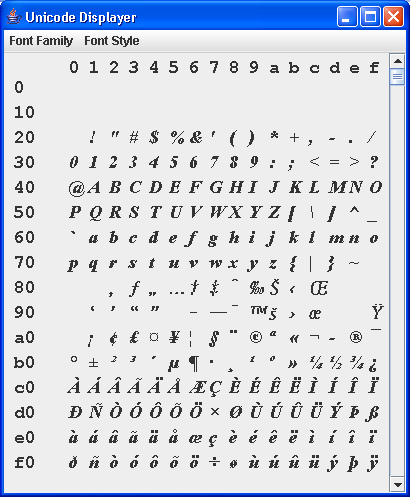Unicode Display

/*
* Copyright (c) 2000 David Flanagan. All rights reserved.
* This code is from the book Java Examples in a Nutshell, 2nd Edition.
* It is provided AS-IS, WITHOUT ANY WARRANTY either expressed or implied.
* You may study, use, and modify it for any non-commercial purpose.
* You may distribute it non-commercially as long as you retain this notice.
* For a commercial use license, or to purchase the book (recommended),
* visit http://www.davidflanagan.com/javaexamples2.
*/
import java.awt.Dimension;
import java.awt.Font;
import java.awt.Graphics;
import java.awt.Scrollbar;
import java.awt.event.ActionEvent;
import java.awt.event.ActionListener;
import java.awt.event.AdjustmentEvent;
import java.awt.event.AdjustmentListener;
import java.awt.event.KeyAdapter;
import java.awt.event.KeyEvent;
import java.awt.event.WindowAdapter;
import java.awt.event.WindowEvent;
import javax.swing.JComponent;
import javax.swing.JFrame;
import javax.swing.JMenu;
import javax.swing.JMenuBar;
import javax.swing.JMenuItem;
import javax.swing.JScrollBar;
/**
* This program displays Unicode glyphs using user-specified fonts and font
* styles.
*/
public class UnicodeDisplay extends JFrame implements ActionListener {
int page = 0;
UnicodePanel p;
JScrollBar b;
String fontfamily = "Serif";
int fontstyle = Font.PLAIN;
/**
* This constructor creates the frame, menubar, and scrollbar that work
* along with the UnicodePanel class, defined below
*/
public UnicodeDisplay(String name) {
super(name);
p = new UnicodePanel(); // Create the panel
p.setBase((char) (page * 0x100)); // Initialize it
getContentPane().add(p, "Center"); // Center it
// Create and set up a scrollbar, and put it on the right
b = new JScrollBar(Scrollbar.VERTICAL, 0, 1, 0, 0xFF);
b.setUnitIncrement(1);
b.setBlockIncrement(0x10);
b.addAdjustmentListener(new AdjustmentListener() {
public void adjustmentValueChanged(AdjustmentEvent e) {
page = e.getValue();
p.setBase((char) (page * 0x100));
}
});
getContentPane().add(b, "East");
// Set things up so we respond to window close requests
this.addWindowListener(new WindowAdapter() {
public void windowClosing(WindowEvent e) {
System.exit(0);
}
});
// Handle Page Up and Page Down and the up and down arrow keys
this.addKeyListener(new KeyAdapter() {
public void keyPressed(KeyEvent e) {
int code = e.getKeyCode();
int oldpage = page;
if ((code == KeyEvent.VK_PAGE_UP) || (code == KeyEvent.VK_UP)) {
if (e.isShiftDown())
page -= 0x10;
else
page -= 1;
if (page < 0)
page = 0;
} else if ((code == KeyEvent.VK_PAGE_DOWN)
|| (code == KeyEvent.VK_DOWN)) {
if (e.isShiftDown())
page += 0x10;
else
page += 1;
if (page > 0xff)
page = 0xff;
}
if (page != oldpage) { // if anything has changed...
p.setBase((char) (page * 0x100)); // update the display
b.setValue(page); // and update scrollbar to match
}
}
});
// Set up a menu system to change fonts. Use a convenience method.
JMenuBar menubar = new JMenuBar();
this.setJMenuBar(menubar);
menubar.add(makemenu("Font Family", new String[] { "Serif",
"SansSerif", "Monospaced" }, this));
menubar.add(makemenu("Font Style", new String[] { "Plain", "Italic",
"Bold", "BoldItalic" }, this));
}
/** This method handles the items in the menubars */
public void actionPerformed(ActionEvent e) {
String cmd = e.getActionCommand();
if (cmd.equals("Serif"))
fontfamily = "Serif";
else if (cmd.equals("SansSerif"))
fontfamily = "SansSerif";
else if (cmd.equals("Monospaced"))
fontfamily = "Monospaced";
else if (cmd.equals("Plain"))
fontstyle = Font.PLAIN;
else if (cmd.equals("Italic"))
fontstyle = Font.ITALIC;
else if (cmd.equals("Bold"))
fontstyle = Font.BOLD;
else if (cmd.equals("BoldItalic"))
fontstyle = Font.BOLD + Font.ITALIC;
p.setFont(fontfamily, fontstyle);
}
/** A convenience method to create a Menu from an array of items */
private JMenu makemenu(String name, String[] itemnames,
ActionListener listener) {
JMenu m = new JMenu(name);
for (int i = 0; i < itemnames.length; i++) {
JMenuItem item = new JMenuItem(itemnames[i]);
item.addActionListener(listener);
item.setActionCommand(itemnames[i]); // okay here, though
m.add(item);
}
return m;
}
/** The main() program just create a window, packs it, and shows it */
public static void main(String[] args) {
UnicodeDisplay f = new UnicodeDisplay("Unicode Displayer");
f.pack();
f.show();
}
/**
* This nested class is the one that displays one "page" of Unicode glyphs
* at a time. Each "page" is 256 characters, arranged into 16 rows of 16
* columns each.
*/
public static class UnicodePanel extends JComponent {
protected char base; // What character we start the display at
protected Font font = new Font("serif", Font.PLAIN, 18);
protected Font headingfont = new Font("monospaced", Font.BOLD, 18);
static final int lineheight = 25;
static final int charspacing = 20;
static final int x0 = 65;
static final int y0 = 40;
/** Specify where to begin displaying, and re-display */
public void setBase(char base) {
this.base = base;
repaint();
}
/** Set a new font name or style, and redisplay */
public void setFont(String family, int style) {
this.font = new Font(family, style, 18);
repaint();
}
/**
* The paintComponent() method actually draws the page of glyphs
*/
public void paintComponent(Graphics g) {
int start = (int) base & 0xFFF0; // Start on a 16-character boundary
// Draw the headings in a special font
g.setFont(headingfont);
// Draw 0..F on top
for (int i = 0; i < 16; i++) {
String s = Integer.toString(i, 16);
g.drawString(s, x0 + i * charspacing, y0 - 20);
}
// Draw column down left.
for (int i = 0; i < 16; i++) {
int j = start + i * 16;
String s = Integer.toString(j, 16);
g.drawString(s, 10, y0 + i * lineheight);
}
// Now draw the characters
g.setFont(font);
char[] c = new char[1];
for (int i = 0; i < 16; i++) {
for (int j = 0; j < 16; j++) {
c[0] = (char) (start + j * 16 + i);
g.drawChars(c, 0, 1, x0 + i * charspacing, y0 + j
* lineheight);
}
}
}
/** Custom components like this one should always have this method */
public Dimension getPreferredSize() {
return new Dimension(x0 + 16 * charspacing, y0 + 16 * lineheight);
}
}
}
Related examples in the same category